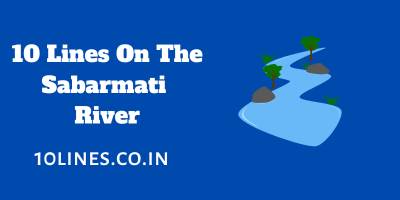10 Lines On The Sabarmati River: Hey students, are you looking for a 10-line essay on the well-known Sabarmati River? If so, you can find several sets of Sabarmati River 10-line essays below. Each set contains important facts about the Sabarmati River. Choose a pair of essays that are ideal for you, or read all three to learn much about the subject. The various sets of data are based on the various student levels.

10 Lines On Sabarmati River For Children And Students
The Sabarmati River and its origin, length, basin characteristics, cultural significance, tributary rivers, well-known locations, and other details are extensively covered in the article.
Sabarmati, one of the significant rivers of Gujrat is well known for the Sabarmati Ashram situated on its bank by Mahatma Gandhi. It rises in the Aravalli range and falls into the Arabian sea also Known as the Gulf of Khambhat. It is a lifeline for the major cities that lies on its riverbank as it provides the main source of water for them.
For more information on the Sabarmati River, keep reading.
Set 1] 10 Lines On Sabarmati River For Children:
1] The Sabarmati is a river that flows only during the monsoon and has little to no flow after the monsoon.
2] It rises from the Aravalli Range in the Rajasthan district of Udaipur.
3] It runs across the states of Rajasthan and Gujarat before entering the ” Bay of Cambay”.
4] The Sabarmati River runs typically in a south-westerly direction from its source in the Aravalli Hills.
5] Mahatma Gandhi’s Sabarmati Ashram is located in Ahmadabad on the banks of the Sabarmati River.
6] Ahmedabad and Gandhinagar are two prominent cities on the banks of the Sabarmati River.
7] The average flow rate of the Sabarmati River is 120 m3/s.
8] In terms of the amount of water consumed, it is the most exploited river.
9] According to the 2001 census, 13.3 million people reside close to the Sabarmati basin.
10] The Sabarmati River is also considered a national waterway NW87 for waterway transportation.
Set 2] 10 Lines On Sabarmati River For School Students:
1] Sabarmati is one of Gujrat’s three main rivers, with a length of 371 km and a catchment area of 21,674 sq. km.
2] The Aravalli Hills border the basin on the east and the Rann of Kutch on the west.
3] The Sabarmati River is believed to have emerged as a result of ascetic Kashyapa’s penance on Mount Abu.
4] The basin lies in a semi-arid zone, with rainfall ranging from 450 to 800 mm in different areas.
5] In Gujarat, the Sabarmati River flows into the Gulf of Khambhat.
6] Dharoi Dam and Vasna Barrage are two significant dams built across the Sabarmati River.
7] Sabarmati rises from Dhebar Lake in Rajasthan’s Aravalli Hills, at an elevation of 762 metres near the village of Tepur.
8] Majorly agricultural land in the area depends on the Sabarmati for irrigation as it provides major source of water.
9] Sabarmati Riverfront is a waterfront development in Ahmedabad that is being built along the banks of the Sabarmati River.
10] Every year in celebration of Makar Sankranti, the famous International Kite Festival is held on the banks of the Sabarmati.
Set 3] 10 Lines On Sabarmati River For College Students:
1] The monsoon-fed Sabarmati River divides Ahmedabad into its western and eastern parts as it runs north to south through the city.
2] The Sabarmati River begins in the Aravalli Range, in the district of Udaipur, at an elevation of 782 metres.
3] The Sabarmati River has been the lifeline of Ahmedabad since the city was founded along its banks in 1411.
4] The major tributaries that fed Sabarmati are the Wakal River, Hathmati River, Harnav River, Watrak River, and Sei River.
5] The area of the Sabarmati basin is approx. 22,000 km2, with 19% in Rajasthan and the remaining in Gujarat.
6] Sabarmati Riverfront is a waterfront development in Ahmedabad that is being built along the banks of the Sabarmati River.
7] A small electricity generating station called the Sabarmati Hydro Plant was built on the Sabarmati River.
8] Since the river bed is exceptionally fertile, it is possible for the locals to practise farming there during the summer when it entirely dries out.
9] It also provides around 70 million litres of water per day to Ahmedabad, making it one of the ten most water-stressed river basins in the world.
10] According to the Central Pollution Control Board (CPCB), the Sabarmati is India’s second most polluted river.
Thank you for taking the time to read this article about the Sabarmati River, everyone. We hope that you will find the content to be clear and useful. Our primary objective is to present information in a simple manner that will help you remember it. Utilize any portion of this content to help you wherever you need it to prepare for essay contests, projects, or exams. Tell us in the comments area how it has been useful for you.